

On Saturday afternoon, July 8th, 2000, I sat down in San Francisco with Alain Delangle, chef/owner of Le Charm French Bistro. I wanted to discuss the differences between French restaurants in the United States and restaurants in his native France. But, as you will find, the conversation did not always remain on course.
Chef Delangle has been cooking, starting with pastry, since he was a child. As he put it, “After lunch, I was still hungry and I made pastry for myself.” At 16, he attended Ecole Ferrandi, one of the premier cooking schools in France. Upon completion of his studies, he started his restaurant career in the kitchens of France. He was sous chef at Morot Gaudry when he met his future wife, Lina Yew, of San Francisco. As he put it, “We had to decide whether to open an American restaurant in Paris, or a French restaurant in San Francisco.”

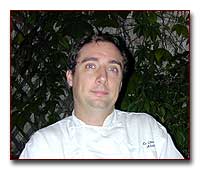
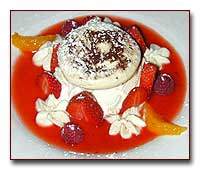



©2000, 2014 Peter Hertzmann. All rights reserved.

à la carte: So, you actually came to San Francisco to open Le Charm?
Chef Delangle: No, I came here to do catering. And I used to have a catering business — mainly for galleries. I was looking for a bigger kitchen to expand my catering business when I found Le Charm. It was empty for lunch, and I said okay, so we opened the restaurant for lunch and did catering at night. We did that for about six months. Then we slowly started to open on Friday and Saturday nights. After that Thursday — then Wednesday — and now we are open five days and six nights each week. So, no more catering!
à la carte: When did Le Charm actually open?
Chef Delangle: We opened September 19th, 1994.
à la carte: And your goals were not initially to open a restaurant?
Chef Delangle: No, it just happened that way. My goal was to do catering. I thought this city needed a catering company — one that could provide fine French catering — there isn’t one in the city. I wanted to create very nicely “turned” hors d’oeuvres and stuff like that for gallery openings. I still have a couple of customers from galleries.
à la carte: Do you like the restaurant business better than the catering business?
Chef Delangle: They are two different approaches. When you do catering, you have to go to the customers. When you have a restaurant, customers come to you. You don’t have to move. So, it’s a very different approach. Both businesses are very interesting. It’s more difficult to operate a restaurant than to do catering. At least with catering, you know what you’re going to cook, and you can plan ahead. People do not just show up at your door and say, “Hey, I’m having a party of 50 tonight.” With catering it’s, “I’m having a party of 50 in three weeks” — so you can plan ahead. When you have a restaurant, every time you open the door, you never know how busy you’re going to be, and that makes it more challenging and more difficult.
à la carte: So, what have been the rewards for you of running the restaurant?
Chef Delangle: The rewards? Well, the customers’ happiness is the best reward you can get. When people come to the back and say, “That was another great meal,” that is the best reward you can ask for — that’s all I need.
à la carte: But I assume there have been problems along the way, what have those been?
Chef Delangle: Not enough space, and sometimes it’s difficult to have enough good workers. I’m not complaining, because we have very good workers now — we’re very lucky. All the time we have to say, “Oh, now we are serving this many customers a week, and we need a storage room, or we need a walk-in.” There was nothing here when we started, not even a walk-in! Now we need to expand the stove — we need another one — and that’s the kind of problem we face every time we expand the capacity of the restaurant.
à la carte: Were there any specific problems you ran into because you are a French restaurant?
Chef Delangle: No, French food is pretty well accepted in San Francisco. And it has become more and more fashionable to have a bistro. As with gastronomic French restaurants, the number of bistros have grown in the past five years. It’s amazing! When I opened, there was only Fringale and South Park Café — at least in this neighborhood.
à la carte: In San Francisco now, as far as French, there is Fringale, La Folie…
Chef Delangle: But, La Folie is not a bistro, it’s more like a gastronomic restaurant. You have to be very careful when you’re talking about French restaurants. There are different categories — you have a café, you have a bistro, you have a brasserie, you have a gastronomic restaurant.
à la carte: Do you think Americans understand the differences?
Chef Delangle: I’m not so sure they do understand the difference, but I’m sure when the bill comes they see the difference! It’s a very different way of cooking, it’s a very different way of thinking, and you will have a different atmosphere if you go to a café, if you go to a bistro, or if you go to a brasserie. The brasserie should be open all day — almost 24 hours a day. It’s open early for breakfast and it closes for dinner at 2 o’clock in the morning. Bistros close in the afternoon. Typical bistro hours are open for lunch, closed in the afternoon, and then open for dinner. Typical brasserie hours are open all day.
à la carte: What about a café?
Chef Delangle: But a café doesn’t sell food. It just sells snacks. Snacks are very, very specific in France. People go to a brasserie when they want specific items, like fresh oysters or choucroute or something very specific that is not served in a café. But if they go to a café, they will have a croque-monsieur, a quiche, or something like that, and maybe a little beer on the terrasse. So it’s very, very different.
à la carte: In defining Le Charm as a bistro, are you forced into a category that sometimes you’d like to be outside of?
Chef Delangle: Oh, yes, sometimes I wish that if I had more energy and more opportunity, I could open Le Charm Brasserie. Then people will understand maybe that a brasserie is bigger. It has to be able to seat 150 people, and the food will be different. Then there could be Le Charm Bistro and Le Charm Brasserie — and why not Le Charm Café? So you have all these different foods and different atmospheres — if you can create it. But, I’m not going to do it, it would be too much of a headache.
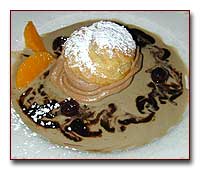
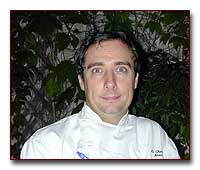
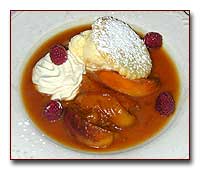




©2000, 2014 Peter Hertzmann. All rights reserved.

à la carte: Do you run into problems where the expectations of your guests, with respect to what French food should be, is different from what you serve?
Chef Delangle: Yes. It has happened a couple of times. Like for example, I remember maybe two or three years ago, I had this customer who came to me and said, “The tarte Tatin should be made with a puff pastry dough.” And I said, “No, tarte Tatin can be made with any kind of dough you want.” He was so sure of himself that I checked in my [culinary] encyclopedia — it can be made with any kind of dough you want.
à la carte: What kind of dough did the Tatin sisters use?
Chef Delangle: I think they used pâte brisée. The reason people think it’s done with puff pastry is because in restaurants, the left over puff pastry is used for the Tatin. This is a way of recycling the puff pastry which they don’t know what to do with. But I don’t do puff pastry, so I can use pâte brisée or pâte sablée — whatever comes to mind. It’s not a specific thing. And I want to be correct on this because I don’t want to call something that it’s not — if I call it coq au vin, it’s a coq au vin. If I call it tarte Tatin, it’s going to be a tarte Tatin. So, yes, sometimes people don’t know, even sometimes in newspaper articles. There was one article that said I should use Tabasco in coq au vin. Well, you know, I smiled and laughed about it. When I had a couple of friends over, I bought them a little bottle of Tabasco sauce and said “…in case you read the article!”
à la carte: Well, I thought you can find Tabasco sauce now all over France?
Chef Delangle: Yes, but you don’t find it in the coq au vin!
à la carte: But, where do you get the roosters to make coq au vin?
Chef Delangle: Well, I can’t, you know. Also, you should have chicken blood to finish the sauce for coq au vin, but I know that I’m not going to find any in San Francisco. So I substitute — I adapt. But there’s still no Tabasco in the coq au vin!
à la carte: Do you ever serve dishes that Americans think of as French, but are not?
Chef Delangle: No, no, I don’t do that. But, for example, most people think ravioli is only Italian. The French do it also, but they call it raviole. We don’t put the “i” at the end and it becomes French.
à la carte: So, do people ever complain about Le Charm being too “French,” or maybe not “French” enough?
Chef Delangle: Not that I know.
à la carte: Are there any French dishes you’d like to serve that you haven’t been able to because you think people wouldn’t appreciate them?
Chef Delangle: Yes, andouillette. I tried that and it didn’t work. Also, veal liver. I tried it, and it didn’t work. Only sweetbreads worked. But people are not too crazy about most of the organ meats.
à la carte: That’s interesting, liver used to be a common selection on San Francisco menus in the 1950s.
Chef Delangle: Now, it’s not. People don’t want it. Every time I make liver, it doesn’t sell. That’s good for us actually because we have plenty then for the staff. I also tried blood sausage. It was kind of funny because as a main course, people didn’t order it. As an appetizer, they did, but usually as a shared appetizer.
à la carte: So, no kidneys either?
Chef Delangle: No, no kidneys. I tried kidneys brochette — it didn’t sell — a veal kidney fiasco!
à la carte: Are there ingredients that you’d like to use from France that you can’t get here?
Chef Delangle: No, everything is pretty much available. We have some very good distributors selling lots of products from France. I don’t find it very difficult today to find anything that I need to do the same cuisine I was doing in France — except the charcuterie.
à la carte: I’ve noticed the cheeses that come from France tend to be a little old.
Chef Delangle: You have to watch out. Sometimes the camembert is passed its prime and it is too strong. The Roquefort is fine — I never have trouble with it. Goat cheese, most of the time, is fine. Soft cheeses can be a problem.
à la carte: Is there a problem finding kitchen staff with proper experience?
Chef Delangle: That’s a real problem in San Francisco, but I don’t think it’s just restaurants, I think all business are having staffing problems.

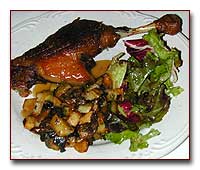
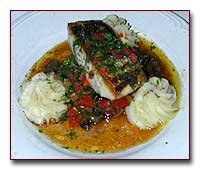




©2000, 2014 Peter Hertzmann. All rights reserved.

à la carte: It seems that for some French cooking, there are some techniques or styles that require different talents?
Chef Delangle: Well, yes, but I think that is true for American cuisine, as well. American cuisine is a mix of different cuisines. You will find a couple of dishes from France, a couple of dishes from Italy — you have a mix of Asian and western foods. I don’t know how they actually do it, because I would be very bad at mixing Chinese and French cuisine together. I may use, for example, some lemon grass or some ginger, and cook it the French way to provide an exotic flavor. But I’m not going to serve fried rice with brochette of beef, or something like that.
à la carte: I’ve noticed in France recently that there’s a lot of Asian ingredients being used.
Chef Delangle: We do, but we adapt those ingredients to French cuisine. We’ve used ginger for a very long time, and lemon grass as well, but we don’t do Chinese-style French or Vietnamese-style French. Soups with a big piece of ginger in them — we don’t do that.
à la carte: How about labor laws? In France, the labor laws have become very difficult for restaurants. Do you have problems with labor laws in San Francisco?
Chef Delangle: No. Here the system is more accommodating to people like me who own a restaurant. You want to work, you work. If you want to work a 30-hour week, you get paid for 30 hours. If you want to work 40 hours, you get paid for 40. That’s it. Simple as that. In France, they get paid for 35 hours and they work 48. And they have no choice.
à la carte: It seems that wait staffs in the U.S. don’t handle as many tables as they do in France. What is your impression?
Chef Delangle: Well, it’s set up differently. In France, we don’t have a busboy, but we have a comis de salle, which has pretty much the same responsibilities. The comis de salle is pretty much an apprentice waiter. He’s going to be a waiter, but he’s still young. He has to learn. The way he learns is by clearing tables. He doesn’t intend to do it the rest of his life. He’s just an apprentice learning the way of serving in France. He’s a comis de salle. After that he will become a chef de rang, which is like a waiter here. Eventually, he’ll become a maître d’hotel, which is like a captain in the U.S. But here you find some people who just want to be a busser, or maybe a food runner — which is a job we don’t have in France. When I was working at La Coupole [possibly the largest brasserie in Paris], it was sort of impressive because the dining room can accommodate 500 people at once. We had 50 maître d’s. Each maître d’ had two chef de rangs, and each chef de rang had one comis de salle. So that’s a lot of people working in the dining room.
à la carte: Do guests expect to be served faster in the U.S. than in France?
Chef Delangle: No. It’s the same. Lunch time, it’s always very fast. It doesn’t matter where you are, people have only an hour to eat. Lunch service in Paris is the same — very fast. You must limit your menu. You don’t have room in the kitchen, as there are only so many burners and that’s it. You’re serving 80 to 100 people for lunch, and they all want to eat at the same time.
à la carte: Do you only do a single seating for lunch?
Chef Delangle: No, we do two seatings — sometimes three.
à la carte: And dinner?
Chef Delangle: Two and a half. But at lunch, customers don’t order appetizers — they don’t have desserts — it’s iced tea and a main course! It’s very rare that guests have dessert — only on Friday. The dessert sales for Fridays are usually double that for the rest of the week. I guess on Fridays people are more relaxed.
à la carte: At one three-star restaurant where I was dining in France, the maître d’ was complaining that Americans always insist on reviewing the entire menu, but usually end up ordering just steak and salad.
Chef Delangle: Well, you know, I have the same thing sometimes. People who don’t know the restaurant will order the onion soup, the salmon, and the tarte Tatin. That’s a classic dinner for the first comer to Le Charm. I’ve seen that so many times. Later on, they will still have the onion soup, but they will switch to the confit and the crème brûlée. And after two or three more visits, they order the strangest things they can find on the menu. Or they will have onion soup and another appetizer and the main course. In case the appetizer they ordered is not to their liking, they have the onion soup to fall back on. I see that very often.
à la carte: Are restaurant reviewers ever a problem?
Chef Delangle: No. We have no control over their review. We are lucky when they give us a call to let us know that we have been reviewed.
à la carte: Do you see a bump in business after a good review?
Chef Delangle: No. We used to. On our first review, yes. It was back in 1995 and I was unprepared for it. That was awful. We doubled the number of guests served in the restaurant in a matter of a week. When you do ten or fifteen per meal, and you switch to 30, it’s still not a lot, but it was for me!
à la carte: Well, when you’ve only planned for ten…
Chef Delangle: Yes, exactly, when you’ve only planned for 10 and suddenly you have 30 people, you say, “oof what’s happening here!”
à la carte: It has been very interesting, and enlightening, talking with you. Thank you for spending the time.
Chef Delangle: You’re welcome.
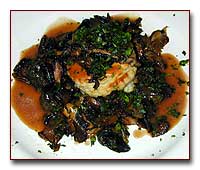

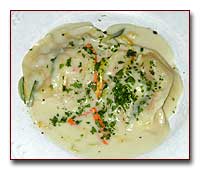



©2000, 2014 Peter Hertzmann. All rights reserved.

















